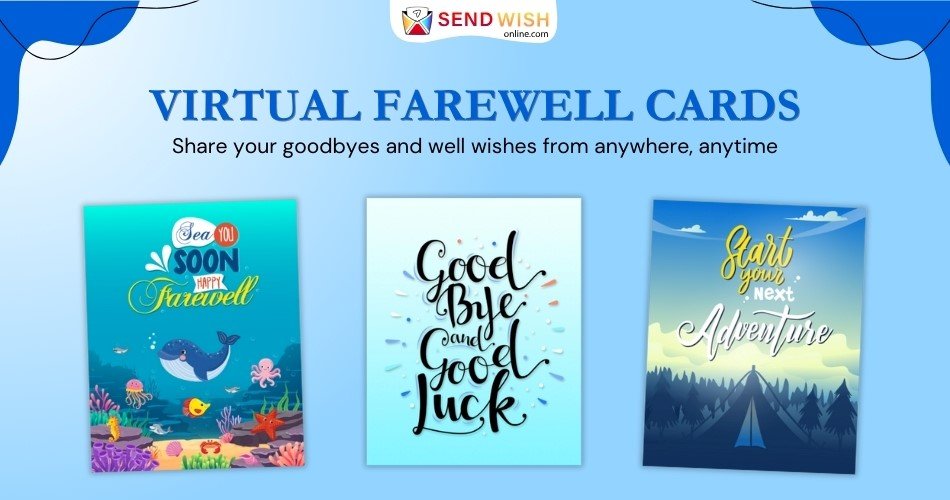In this mostly digitalized world, most of our customs have been altered. Electronic farewell cards have proven to be a very considerate and convenient way for a person to bid farewell when distances come in between the sender and recipient. Whether it is to a colleague moving to another city, a friend starting on a new adventure, or just a loved one moving very far away, digital farewell cards merge technology with sentimentality to ensure that goodbyes are just as meaningful across distances.
Evolution of Farewell Traditions
Goodbyes have traditionally been sealed by getting-togethers, gift-giving, and tearful farewells with final words shared in person. These are deep within culture and have been rituals that paid respect to the outgoing person and gave closure to those who stay behind. But logistics have become increasingly difficult as our lives have become mobile and global.
Here Virtual farewell cards make a difference. Using the internet, digital cards can allow anyone from any location to input their text and best wishes. In this regard, the simplicity and comprehensiveness of virtual farewell cards make them extremely important to contemporary farewell practices.
What Are Virtual Farewell Cards?
Virtual farewell cards are digital cards made and shared on the Internet. Unlike their paper counterparts, these digital farewell cards can accommodate lots of signatures and are always interactive, with videos, images, and animated GIFs. Almost always, they are hosted on specifically designed platforms for group work, which helps people—friends or family members, or colleagues—to jot down their messages easily.
Why Virtual Farewell Cards?
1. Inclusivity Across Distances
Probably the most important benefit of a virtual farewell card is that it bridges geographical distances. In today’s globalized world, a close-knit group may be sitting in different cities, countries, or even continents. Virtual farewell cards make sure that all of them get to be a part of the farewell, no matter which part of the world they are in.
2. Convenience and Flexibility
The virtual farewell card is always available for creation and signing, hence highly convenient for those with the most hectic schedules. No need to coordinate time zones or hunt down some card to circulate. Contributors can add their messages as their time allows—the ultimate in stress-free and flexible procedures.
3. Personalization Options
Customized virtual farewell cards can create a variety of options, from templates and themes to selected fonts and texts, to sound as similar as possible to the tone of a person’s being celebrated. Other multimedia elements can be included in some to make it a little livelier and more interactive, turning the card into a more engaging experience.
4. Environmentally Friendly
Now, with improved awareness about environmental sustainability, comes the greener option offered by using virtual farewell cards as opposed to traditional paper cards. Going online reduces the use of paper, the consumption of ink, and problems in shipping, thus causing a minimal carbon footprint.
5. Memento for the Person Leaving
The digital farewell card can be saved and looked upon at any time, which gives something tangible to the person leaving as well. Unlike a paper card, which may be thrown away by someone else, lost, or torn, the e-card will be present for years and he/she can see the memories whenever they like.
How to Make a Virtual Farewell Card
Now, making a farewell card virtually today is pretty easy with the aid of a wide variety of platforms. Here’s a step-by-step way through which you can create it:
1. Choice of platform
There are a few online platforms available that can help you easily design virtual farewell cards. You can consider using Kudoboard, GroupGreeting, or eCardWidget, as they are commonly used. Since each platform comes with its functionalities, settle for a choice that will suit your needs based on customization, number of contributors you would like to involve, or even kinds of multimedia support.
2. Select a Template
After choosing a platform, one can see the different types of templates they have. Most of the platforms have varying designs—from very formal and professional to more fun and casual. Choose something that would resonate with the recipient’s personality and the mood of the farewell.
3. Edit the Card
Once you select a template, go on to give your card a personal touch. Write the name of the person receiving the card and then write your message. If occasion demands, you can insert more images or video. Within the limits of the website, you can personalize the card under the color scheme, multiple font styles, and layout if available as features on the site.
4. Involve Contributors
Now, share the card with others for their contributions. Most of the platforms provide a sharing link via email or messaging apps. Invite friends, family members, or colleagues to add their messages, photos, or videos to your card. In some places, scheduling reminders are allowed and make sure that everyone gets an opportunity to contribute before finalizing the card.
5. Review and Finalize
Once all the entries have been added, go ahead and look over your card to check everything is okay. Look out for typos—make sure the multimedia elements are working as they should, etc. Further editing may be done thereafter in order to really fine-tune the card.
6. Send or Publish the Card
Now that you are satisfied with the final result, it is time to send or present the card. Most of these platforms offer options to share the card by e-mail or download it as a PDF for printing. You can also present the card during a virtual farewell party by sharing your screen with the group so that everyone gets to see the final creation.
Creative Ideas for Virtual Farewell Cards
Make your online farewell card much more special by adding these creative ideas that can make it much more than just a set of farewell messages.
1. Video Messages:
Ask invitees to record small video messages of goodbyes. This gives a touch of personalization and allows the person walking out of the organization to view and hear from his friends and colleagues, which is quite sentimental.
2. Memory Collage
Create a photo collage of some great moments you have shared with the person leaving. This might be some group photos, event snapshots, or just candid shots that sum up the time you spent together.
3. Interactive Elements
Very few platforms enable interactive elements like polls or quizzes. You could create a fun quiz about the person leaving: contributors answer questions related to their favorite memories or characteristics.
4. Incorporate some music
Where possible, you can also include some background music in your virtual farewell card. Choose a song that might have some significance to your group or cue something up that supports the tone of the farewell.
5. Whimsical GIFs
Incorporate whimsical GIFs or animations that represent the individual’s whimsical nature. To make it playfully interactive, use this kind of card for more appeal.
Virtual Farewell Cards in the Workplace
Virtual farewell cards have been one of the most prominent tools that help in keeping up team spirit in a professional setting and showing appreciation for the colleagues who are leaving. Whether someone is retiring, moving to another department, or leaving for another opportunity, the virtual farewell card can help in conveying the good wishes of the whole team.
1. Keeping the Team Spirit Intact
When some team member leaves the team, it often could be a blow to the morale of the team. With the help of virtual goodbye cards, team spirit remains high because every person can write in the card whatever is in their minds and thank the person leaving. That way, the one leaving will feel acknowledged or at least appreciated, and at the same time, there is a closure for the remaining team.
2. Recognizing Contributions
Virtual farewell cards provide an avenue for recognizing the contributions and success of the departing colleague. Team members may comment on specific projects or achievements to ensure that the person is acknowledged and appreciated for his efforts.
3. Strengthening Bonds
Even when a colleague departs, the ties at work are rarely broken. Virtual farewell cards give support to these bonds and relations by conserving all the memories and relations built up during the person’s service in the organization. This makes way for professional relations and networking through such colleagues in the days to come.
Virtual Farewell Parties: Enhancing the Experience
Instead of just sending a virtual farewell card, use it to hold a virtual farewell party. Do it through video conferencing media, including Zoom and Microsoft Teams, which allow all the employees to log in and be together to make the most of it for one last time.
1. Sharing the Virtual Farewell Card
Now during the virtual farewell party, make things take a slightly somber note by displaying the virtual farewell card to the person leaving. Share the screen with all of them and read out a few messages so the sentiment really sinks in. This is the poignant moment for adding an emotional quotient to the farewell.
2. Engaging Activities
Plan some interactive activities so that group members remain engaged in the virtual farewell party. The activities could include playing trivia games that revolve around the person who is leaving, sharing a slideshow of common memories, or giving a virtual toast where everybody raises their glass and toasts for their good times.
3. Farewell Speeches
Request the team members or friends to raise up little speeches for farewell. This gives an avenue for people to express appreciation and tell stories that personalize the farewell.
4. Virtual Gifts
Think of having a virtual gift for your team member. That may be a digital gift Group card, an online course, or the subscription they love. Virtual gifts will go well along with your virtual farewell card and brighten it up.
For more information, visit: vestikurir





